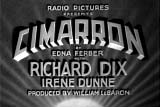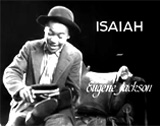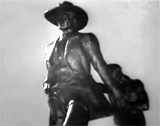
|
Cimarron (1931)
In this early RKO sound western and Best Picture/Production
winner (undeserving) based on the best-selling Edna Ferber epic by
director Wesley Ruggles, covering the time period from 1889 to 1929:
- the breathtaking reenactment of the homesteaders'
wild dash in the Oklahoma Land Rush of 1889, prefaced by the opening's
second title screen: "In 1889, President Harrison opened the
vast Indian Oklahoma Lands for white settlement... 2,000,000 acres
free for the taking, poor and rich pouring in, swarming the border,
waiting for the starting gun, at noon, April 22nd"
- the relationship between ambitious adventurer Yancey
Cravat (Richard Dix), a newspaper editor-publisher and progressive
thinker, and his strong-willed wife Sabra (Irene Dunne) (often called "Sugar"),
and Yancey's frequent wanderlust nomadic spirit that often led him
to abandon his loving wife and family
- the embarrassing, racist characterization (although
common at the time) of the Cravat's uneducated black servant boy
Isaiah (Eugene Jackson), whistling and shining shoes in the film's
opening credits, and his main role to provide comic relief, and his
joyful exclamation when Yancey pointed out an overflowing cart selling
watermelons when they pulled into Osage, Oklahoma!: ("Yah sir,
I'm sure glad I came to Oklahome!")
|
Racist Characterizations
|

|

|
- Yancey's courtroom defense of brothel madam Dixie
Lee (Estelle Taylor) in the local town when she was accused of
adultery, and his winning of her acquittal after a speech to the
jury about how she should be judged for her actions and not her
guilt: ("Why gentlemen, a thief or murderer may sin alone
and is alone to blame, but this woman is not alone. Social order
is her accomplice. If she is guilty, then all in this room are
guilty")
- the concluding reunion-reconciliation scene between
Sabra and her lethally-injured husband Yancey after an act of heroic
bravery in rescuing oil drillers, when they embraced and he passed
away
- the film's last image - the unveiling of a memorial
statue (of Yancey?) - a commemorative tribute to Oklahoma's forefathers
and pioneers (A.D. 1930)
|


The Oklahoma Land Rush Sequence

Yancey with Sabra

Yancey's Courtroom Defense of Dixie Lee

Memorial Statue
|






